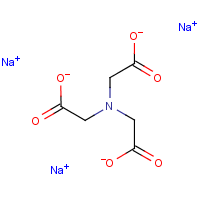Trisodium nitrilotriacetate
Agent Name
Trisodium nitrilotriacetate
CAS Number
5064-31-3
Formula
C6-H9-N-O6.3Na
Major Category
Other Uses

Synonyms
N,N-Bis(carboxymethyl)glycine, trisodium salt; Nitrilotriacetic acid sodium salt; Acetic acid, nitrilotri-, trisodium salt; Cheelox NTA-14, Na3; Chemcolox 365 Powder; Glycine, N,N-bis(carboxymethyl)-, trisodium salt; Hampshire NTA; Hampshire NTA 150; Masquol NP 140; NTA trisodium salt; Nitrilotriacetate trisodium salt; Nitrilotriacetic acid trisodium salt; Nitrilotriacetic acid, trisodium salt; NTANa3; Sodium nitrilotriacetate; Syntron A; Trilon A; Trisodium 2,2',2''-nitrilotriacetate; Trisodium N,N-bis(carboxymethyl)glycinate; Trisodium NTA; Trisodium aminotriacetate; Trisodium nitrilotriacetic acid; Versene NTA 150; Versene NTA 335; [ChemIDplus]
Category
Chelating Agents
Description
White solid; [ICSC] Colorless or white solid; Slightly hygroscopic; [CHEMINFO]
Sources/Uses
Used as chelating agent in bleaching and as a sequestrant builder; Also used in tanning, synthetic rubber, textiles, pharmaceuticals, low phosphate and phosphate-free detergents, and in boiler-water treatment; [HSDB] Used for extraction, refining, and processing of metals; in the paper-pulp-board industry; and as an additive to construction materials; [IUCLID]
Comments
A corrosive substance that can cause injury to the skin, eyes, and respiratory tract; Possible human carcinogen; [ICSC] A skin, eye, nose, and throat irritant; Not sensitizing to human skin; High-dose feeding produces lesions of the urinary tract in mice and kidney lesions in rats; No evidence of reproductive or developmental toxicity in rats or rabbits; Emergency treatment: "Oxalic acid"; Oxalic acid is an irritant that, after ingestion, may cause kidney damage, hypocalcemia, and hepatic necrosis; [HSDB] An eye irritant; [eChemPortal: ESIS] Not irritating to rabbit or human skin; Irritating to rabbit eyes; Nephrotoxic in rats; [IUCLID] Mutagenic, tumorigenic, and toxic to reproduction; Causes changes in liver and bladder weights, erythrocyte count, and renal tubules in repeated dose studies of rats; [RTECS] May cause skin and eye irritation; Harmful if swallowed; [Aldrich MSDS] See "Nitrilotriacetic acid."
Biomedical References
Exposure Assessment
Vapor Pressure
8.08E-10 mm Hg
Lethal Concentration
LC50 (rat) > 5,000 mg/m3/4h
Adverse Effects
Hepatotoxin
Hepatoxic (a) from occupational exposure (secondary effect) or (b) in animal studies or in humans after ingestion
Dermatotoxin
Skin burns
IARC Carcinogen
Possible (2b)
Diseases, Processes, and Activities Linked to This Agent
Processes
Industrial Processes with risk of exposure: